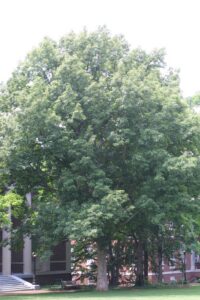Botanical Name:
Quercus muehlenbergia
Family Name:
Fagaceae
Description:
Chinkapin oak is a medium-sized deciduous tree with a pyramidal to rounded crown. Compared to our other oaks, chinkapin has relatively small leaves that are 4-8 inches long, oblong to elliptical in shape, and coarsely toothed. Bark is light gray and flaky. The oval acorns mature in the first year and are about ½ inch with a cup covering half of the nut.
Size:
40-60’ tall; 50-70’ spread
Habitat and Range:
Chinkapin oak is native to most of eastern North America west of the Appalachians. It occupies dry, upland sites and limestone outcrops. It is one of our best oaks for alkaline soils, but it also does very well on more mesic, fertile sites.
Attributes:
Chinkapin oak is also sometimes called chinquapin or yellow chestnut oak, because its leaf shape resembles a chestnut leaf. Plant this species when you are young, because it can take up to 30 years to mature and begin producing acorns. The fall color is modest, with leaves turning yellow to orange-brown.
Wildlife Value:
Like many oaks, the acorns are eaten by both birds and mammals, and the tree hosts many insects that serve as food for birds.
Did you Know?
• The chinkapin name originated in the Algonquian word chinkomen, which means chestnut.
• Like chestnuts, the acorns of chinkapin oaks are sweet and edible. They were once a part of the diet of the now extinct passenger pigeon.
Benefits to Our Community (based on carbon dioxide sequestered, storm water runoff avoided, and air pollution removed each year):
Over the next 15 years, this tree will give back $3,855 worth of benefits to our community.





